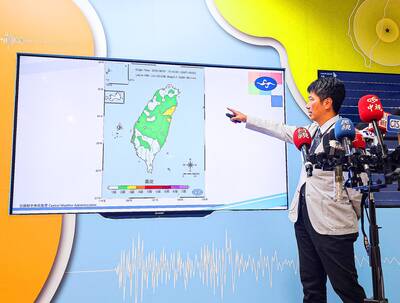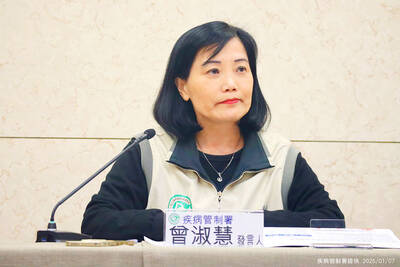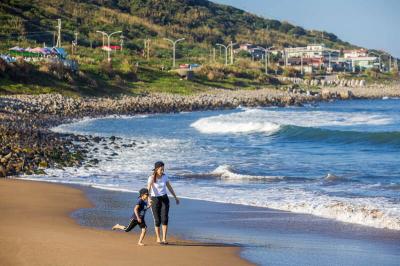Following the complete sequencing of the human genome there remain layers of unresolved mysteries as to how genetic materials are regulated, but a group of Academia Sinica scientists recently shed some new light as to how certain genetic expressions may be switched on or off.
The team, led by Academia Sinica's Institute of Biological Chemistry director Tsai Ming-Daw (蔡明道) and Juan Li-jung (阮麗蓉), an assistant research fellow at Academia Sinica's genomics research center, is due to publish the results in Nature magazine, an international science weekly.
"In addition to DNA sequences, epigenetic regulation also plays a role in genetic expressions," Juan told the Taipei Times in a telephone interview last night.
Epigenetic regulation refers to the different genetic expressions the same DNA sequence may incur because of a change in the histone proteins, which are wrapped around DNA sequences, Juan said.
For example, normally tumor suppressors in our nuclei are turned on. However, an alteration in the histone protein around the suppressors may cause it to be turned off, causing a cancer to form, she said.
Though the team's research target RBP2 -- an enzyme and a histone modifier -- was discovered years ago, the team is the first to have successfully found the specific DNA sequence that it recognized, she said.
"This is exciting because hundreds of histone modifiers have been identified, but few are known to recognize specific DNA sequences," she said. "It is significant that with random sequencing tools producing thousands of DNA sequences, we proved when associated with CCGCCC, RBP2 acts as a histone demethylase and removes trimethyl groups attached to histones ... confirming that histones with three methyl groups act as optional modifiers of the DNA sequence."
Juan said many cancer patients have abnormally high RBP2 levels in their cells, which is a clue that the enzyme may be the culprit.
However, "it is all speculation until further evidence is found," she said.
The team's next step is to find out exactly which gene RBP2 is associated with, she said.

Aftershocks from a magnitude 6.2 earthquake that struck off Yilan County at 3:45pm yesterday could reach a magnitude of 5 to 5.5, the Central Weather Administration (CWA) said. Seismological Center technical officer Chiu Chun-ta (邱俊達) told a news conference that the epicenter of the temblor was more than 100km from Taiwan. Although predicted to measure between magnitude 5 and 5.5, the aftershocks would reach an intensity of 1 on Taiwan’s 7-tier scale, which gauges the actual effect of an earthquake, he said. The earthquake lasted longer in Taipei because the city is in a basin, he said. The quake’s epicenter was about 128.9km east-southeast

The Taipei Summer Festival is to begin tomorrow at Dadaocheng Wharf (大稻埕), featuring four themed firework shows and five live music performances throughout the month, the Taipei Department of Information and Tourism said today. The festival in the city’s Datong District (大同) is to run until Aug. 30, holding firework displays on Wednesdays and the final Saturday of the event. The first show is scheduled for tomorrow, followed by Aug. 13, 20 and 30. To celebrate the 30th anniversary of Disney Pixar's movie Toy Story, the festival has partnered with Walt Disney Co (Taiwan) to host a special themed area on

BE CAREFUL: The virus rarely causes severe illness or death, but newborns, older people and those with medical conditions are at risk of more severe illness As more than 7,000 cases of chikungunya fever have been reported in China’s Guangdong Province this year, including 2,892 new cases last week, the Centers for Disease Control (CDC) yesterday said it is monitoring the situation and considering raising the travel notice level, which might be announced today. The CDC issued a level 1 travel notice, or “watch,” for Guangdong Province on July 22, citing an outbreak in Foshan, a manufacturing hub in the south of the province, that was reported early last month. Between July 27 and Saturday, the province reported 2,892 new cases of chikungunya, reaching a total of 7,716

The New Taipei City Government today warned about the often-overlooked dangers of playing in water, and recommended safe swimming destinations to cool off from the summer heat. The following locations in the city as safe and fun for those looking to enjoy the water: Chienshuiwan (淺水灣), Baishawan (白沙灣), Jhongjiao Bay (中角灣), Fulong Beach Resort (福隆海水浴場) and Sansia District’s (三峽) Dabao River (大豹溪), New Taipei City Tourism and Travel Department Director-General Yang Tsung-min (楊宗珉) said. Outdoor bodies of water have variables outside of human control, such as changing currents, differing elevations and environmental hazards, all of which can lead to accidents, Yang said. Sudden